Thesis, antithesis, and synthesis
Summary: Storytellers can use a thesis-antithesis-synthesis story structure to illustrate change and convey a story’s thematic argument.
“The hero . . . discovers and assimilates his opposite. . . . He must put aside his pride, his virtue, beauty, and life, and bow or submit to the absolutely intolerable. Then he finds that he and his opposite are not of differing species, but one flesh.”
— Joseph Campbell (Campbell, Page 160)
In storytelling, thesis-antithesis-synthesis is a structural tool for illustrating change and conveying theme.
“You take a thesis. That’s a statement. Something is true. And then you apply to that an antithesis. ‘No, that’s not true and here’s why.’ Those things collide and in theory what results from that is a new thesis called the synthesis.” (Mazin)
Structurally, thesis-antithesis-synthesis uses a complex bracketing form to demonstrate change. Thus, it’s based on comparisons, and its main effect is to convey meaning to the audience.
In addition to being a bracketing form, thesis-antithesis-synthesis is a particular application of the rule of three. As such, the form may also help deliver satisfaction, especially when applied to the whole-story level.
Theme in three-act structure
On a high level, thesis-antithesis-sythesis can be viewed in terms of a three act structure. Using mythologist Joseph Campbell’s terminology (with interpretation by screenwriter and story theorist Christopher Vogler), the Ordinary World in the first act is the thesis. (Vogler, Page 103) The Special World of the second act is the antithesis. (Vogler, Page 103) And, the hero’s Return as “master of the two worlds” (Campbell, Page 326) in the third act is the synthesis.
- Act one: thesis
A protagonist begins a story with a “lie she believes.” (Weiland, Page 15) This is the starting thesis we see in the Ordinary World — a claim about the way life works, which the story’s thematic argument will prove is untrue. - Act two: antithesis
The story world and plot repeatedly challenge the protagonist’s mistaken belief until she can no longer hold onto it. In an archetypal character arc, this culminates in an All is Lost moment. (Snyder, Page 86) The protagonist must go on a soul-searching journey (represented by the Dark Night of the Soul phase) (Snyder, Page 88) and come to a point of acceptance (often represented by an Epiphany and Recommitment). (Truby, Page 302) - Act three: synthesis
Newly equipped with the thematic truth of the story (the synthesis), the protagonist challenges and defeats the antagonistic force, “embodying the truth of the theme . . . through action.” (Mazin)
All three in each act
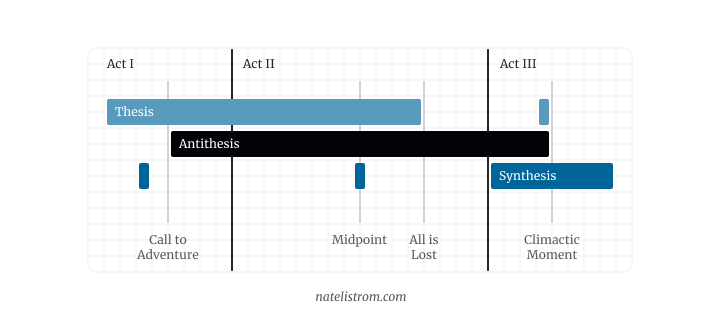
While it’s useful to think broadly about the structure of the thesis-antithesis-synthesis aligning neatly with the three structural acts of the story, in truth all three can (and probably should — at least in larger stories) be present right from the first act.
To see this more clearly, we can take on a perspective from Vogler, who sees thesis and antithesis in terms of the story’s protagonist and antagonist:
“We could say the protagonist’s point of view or style of living is the thesis of the story. The antithesis is the antagonist’s opposing viewpoint and style. The synthesis is whatever resolves the polarized conflict at the end.” (Vogler, Page 403)
First act
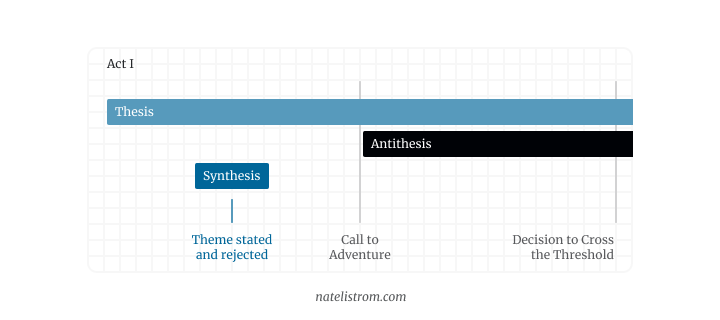
The protagonist is first confronted by the antithesis not during the second act but earlier, in the middle of the first act.
The antagonistic force is often at work even in the beginning of a story. It upsets the balance of the story world in a “Tipping of the Apple Cart”. Yet, while the protagonist may learn of the antagonistic force early on, it’s at the Call to Adventure that the antithesis first becomes becomes the protagonist’s problem. At that point, it’s impossible for her to ignore.
For example, in George Lucas’ 1974 film Star Wars: A New Hope, the story opens with antagonist Darth Vader seeking to recapture a set of stolen plans for a battle station. This introduces the antagonistic force, which protagonist Luke Skywalker must eventually overcome. Later, when Obi-Wan Kenobi invites Luke to become a Jedi, Luke is confronted with whether or not to align himself with the side opposing Vader.
What about the synthesis? It can be there in the first act, too.
In the tradition of the “Hollywood formula” there’s a reflection character who speaks the thematic truth (synthesis) to the protagonist early on in the story. (Kowal) Of course, at that point the protagonist is committed to believing the lie of the thesis, so she rejects it. But it sets up for the story to come.
Let’s look at an example from Crutiz’s 1942 film Casablanca, as explained by editorial director Lou Anders.
Early in the first act, there’s a scene in which protagonist Rick Blaine and Louis, a character designed to help challenge Rick’s thesis, have a conversation.
“The expression of theme is when [Louis] tells Rick, ‘I think you have the letters of transit’ and Rick says, ‘I stick my neck out for no one and nobody.’ And he says, ‘No, you don’t. You’re still a patriot.’” (Kowal)
In the story’s climax, Rick will choose the cause of freedom over his personal desires, an action that confirms Louis’ insight.
“When Rick gives up the girl in the end, he says, ‘I was right, Ricky, you are a patriot.’ They say, ‘This is the beginning of a beautiful friendship.’ Bring the curtain down on that line.” (Kowal)
The payoff in the climax lands because it was set up in the first act. This suggests that even the synthesis, which won’t be triumphant until the third act, has at least a preview in the story’s beginning.
Second act
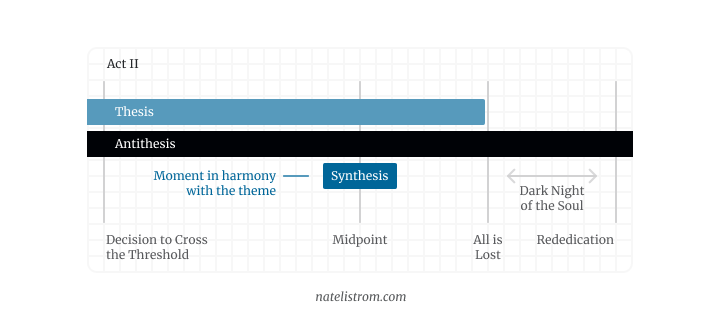
In the second act, the protagonist is confronted with a world that’s different than her own, one where the antithesis looms large. If the first act is the “opening statement” of each side in a trial, the second act is a back-and-forth as the thesis and antithesis each try to argue their case.
In general, the protagonist still pursues her original “thesis” approach through most of the second act. However, she does experience glimpses of the synthesis. This can be especially effective at key moments, like the midpoint of the story. (Mazin)
For example, in the midpoint of Spielberg’s 1993 film Jurassic Park, Dr. Grant risks his life to save the children, an act that’s out of character with his “thesis” of avoiding uncontrollable futures. Yet it gives a significant hint at where his character will be by the end of the story.
In the midpoint of Jane Austen’s 1813 novel Pride and Prejudice, protagonist Elizabeth Bennet and romantic interest Mr. Darcy speak openly to one another for the first time. While it’s an antagonistic exchange, it’s the first chip in their respective armors, opening a way for the relationship to later come to fruition.
In the All is Lost moment and Dark Night of the Soul, the antithesis definitively disproves the protagonist’s thesis. This utter defeat forces the protagonist into a dilemma. She has tried every possible way to rescue her thesis, and nothing has worked. To move on, she must finally abandon her thesis and accept the truth of the synthesis. (Or, in a tragedy, she is unable to accept the synthesis, and her choice to return obstinately to her failed thesis dooms her.)
In Pride and Prejudice, at the All is Lost moment, Elizabeth’s fifteen-year-old sister elopes with a soundrel. In a piquant Dark Night of the Soul scene, Elizabeth realizes that Mr. Darcy can now no longer associate with her because of the social stigma. While before she disdained his regard (thesis), to her surprise, she finds she grieves the loss. This introduces the first hint that maybe there was something between her and Mr. Darcy after all (synthesis).
Third act
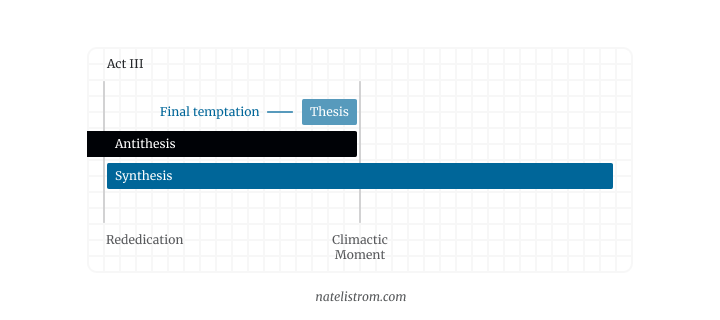
In the beginning of the third act, the protagonist has often accepted the truth of the synthesis but not yet fully embraced it. That’s what happens in the climactic moment.
The protagonist may face a temptation to return to the thesis. She must reject that temptation and completely inhabit the synthesis. (Mazin)
For example, there’s a moment in Star Wars: A New Hope in which Luke must choose between using the conventional method of defeating the enemy — represented by use of his targeting computer — versus giving himself up to the mystical Force tradition to which he has been introduced. At the enouragement of Obi-Wan to “Trust the Force,” Luke chooses to believe. He switches off the targeting computer, and his decision results in victory.
The final surrender and letting go of the thesis definitively overcomes the antithesis. This restores a new, synthesis-based equilibrium to the world.
Change in individual scenes
I’m a proponent of the fractal theory of story structure. That is, that the core structures of story are repeated at different resolutions, from scene to sequence to act on up.
“Imagine looking at a photograph of the branching of a tree: remove any knowledge of scale or context and it would be impossible to tell whether you were looking at twig, branch or trunk; each unit replicates both a smaller and a larger one. And so it is with drama. Stories are built from acts, acts are built from scenes and scenes are built from even smaller units called beats.” (Yorke, Page 78)
If fractal theory is correct, you should be able to see thesis-antithesis-synthesis working on the individual scene level. And, in fact, it is present.
Editor and Story Grid creator Shawn Coyne suggests that good scenes must involve change. (Coyne, Page 201) Something must be different in the plot or the characters by the end of the scene, or else the scene has no structural purpose in the story.
Thus, every scene must move from a starting point (a thesis) through some kind of opposition (an antithesis) and arrive at a new, changed resolution point (a synthesis).
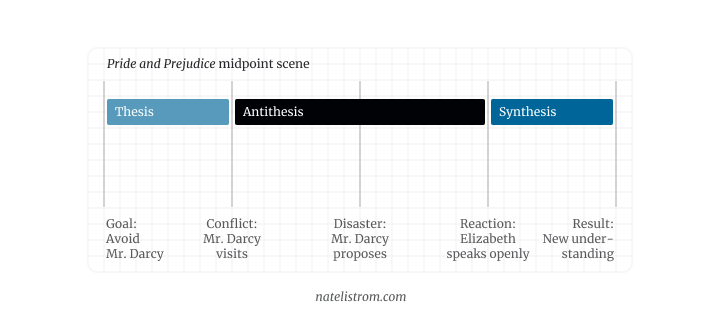
Let’s look a bit closer at the midpoint scene from Pride and Prejudice.
In the scene’s immediate context, Elizabeth has just learned that Mr. Darcy hurt her sister Jane. Jane was in love with Mr. Darcy’s friend, Mr. Bingley. Unbeknownst to Jane, Mr. Darcy contrived to thwart Jane’s chances with Mr. Bingley. Elizabeth smarts from the discovery, livid at how Mr. Darcy so casually and cruelly ruined her sister’s hopes.
Elizabeth’s friends are on their way to visit Rosings Park. Mr. Darcy will be there. So, Elizabeth begs to stay home. Her goal is to have space to process her frustration and — at all costs — to avoid Mr. Darcy. This is the starting point for the scene (thesis).
Her solitude is short-lived however. It’s not long before she receives a visit from none other than Mr. Darcy himself. This introduces the antithesis, the conflict that presents the main opposition to her plan. She wanted to avoid Mr. Darcy, but now he has come to her.
The conflict escalates. Elizabeth is as polite as decorum demands, but she wants Mr. Darcy to leave — and quickly. He does not leave. He moves restlessly around the room until things finally reach a breaking point. Mr. Darcy turns to Elizabeth and, to her shock, proposes that she marry him!
Elizabeth is thunderstruck, but she’s in no state of mind to accept him. The gloves come off, and Elizabeth and Mr. Darcy speak their minds openly for the first time. Elizabeth shares her disdain for Mr. Darcy’s coldness and cruelty, and he conveys his contempt for her social relations’ poor standing and even worse behavior.
While it’s rife with conflict, this shift results in synthesis — deep change that will have story-altering consequences. Each now views their relationship (and the other) very differently than before.
Conclusion
In your own storytelling, thesis-antithesis-synthesis can be a tool for thinking about how to illustrate change and convey theme.
On the scene and sequence level, you can think about it as a way to craft structural markers for the plot. A scene begins with a starting point (thesis). You introduce some form of opposition (antithesis). The two battle with each other, and the thesis becomes untenable. This results in a change (synthesis). Then, the process repeats.
On a whole-story level, you can think of thesis-antithesis-synthesis as a way to communicate your thematic argument. Your protagonist begins with a certain thematic belief (thesis). That belief is challenged and shown to be incorrect (antithesis). To reach resolution, the protagonist must abandon her incorrect belief and embrace a true belief about the world (synthesis).
For more on thesis-antithesis-synthesis, listen to writer and director Craig Mazin’s Scriptnotes podcast episode, “How to Write a Movie,” from which this note borrows heavily.
Rate this note
Read this next
Storytelling and the rule of three: trajectory and payoff
The rule of three is a powerful storytelling mechanic that leverages human psychology to set up and pay off audience expectation in a satisfying way.
Level-up your storytelling
Understand how stories work. Spend less time wrangling your stories into shape and more time writing them.